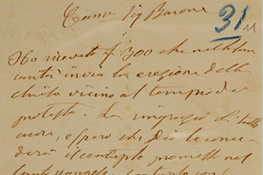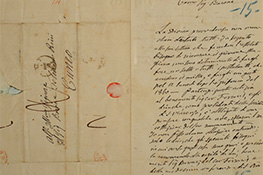Versione italiana English version Version française Versión en español
An interesting fund of six folders contains hundreds of autographed letters acquired by the Province of Turin (now Metropolitan City) at different times, and received through donations from individuals or antique shops. The chronological extremes go from the most ancient writing, a declaration of devotion and benevolence by Duke Carlo Emanuele I of Savoy to Cardinal Tosco, dated 6th January 1613, to two photographs by Ida Pellegrini (wife of President Luigi Einaudi), dating back to 1967-68.
The most substantial corpus of letters, however, is dated 1800. In fact, it refers to personalities operating in the nineteenth century, and belonging to various areas: they are politicians, historians, writers, sculptors.
Among the documents concerning political figures we find 6 letters by Cavour, one attributed to the Countess of Castiglione and dated November 1869 which describes the apprehension of the court for the serious illness of Vittorio Emanuele II, and 3 letters by Maria Vittoria di Savoia Aosta, the last princess Dal Pozzo della Cisterna wife of the first Duke of Aosta, Amedeo, with whom he reigned on the throne of Spain from 1871 to 1873. There is also an autograph of the King of May, Umberto II, on a silographed frame and royal coat of arms in blue, and a bunch of 7 letters of King Carlo Alberto of Savoia, addressed from 1824 to 1829 to the Marquis of Clermont-Tonnerre.
It is difficult to distinguish of course, given the historical and cultural climate of the time, the literati pure by politicians: in fact many characters are ascribable to both categories. For example, there is a dense correspondence involving the various members of the Taparelli D'Azeglio family, that Cesare to whom Manzoni addressed the famous Lettera sul Romanticismo, and his two sons, the patriot, painter and writer Massimo and Roberto, who was the promoter of the emancipation campaign of the religious minorities of Piedmont (Jews and Waldensians). The most interesting letters, however, are perhaps those of Roberto's wife, Costanza Alfieri di Sostegno, a supporter of a liberal opening of the monarchy and animator of a salon frequented by several patriots. In particular, the letters addressed to her aunt Luigia Aglae Due Giriodi contain news of a family but also of a political nature, such as information on the retreat of the French troops after the Battle of Waterloo (letter of 7th July 1815)
Among the other political-literati we find Vincenzo Gioberti, who on 18th February 1848 wrote from Paris to the abbot Germano di Vercelli, telling of his stay in the French capital, with hints at the climate of political tension. There are also four manuscript poems by Costantino Nigra, and a bunch of letters by Silvio Pellico. In one of them, addressed to the curious merchant and playwright Stanislao Marchisio, Pellico encloses the tragedy Laodamia with a prayer of a critical judgment, expressing reflections on his own poetics and models: the gecko theater, Shakespeare and Alfieri. And again, autographed poems by Norberto Rosa, some letters from Brofferio, including one (perhaps addressed to Father Bottari) in which the author describes his stay in Venice and the rich cultural life of the city. Let us quote two more letters by Edmondo De Amicis: the one directed at Domenico Lanza contains peculiar reflections on the theatre.
Particularly interesting is a small correspondence composed of 28 letters by Pietro Giordani, the intellectual and writer from Piacenza friend of Giacomo Leopardi. The letters, dated from 1837 to 1846, are addressed to the Monregalese priest Giuseppe Baruffi, theologian, scholar of botany and agronomy. Giordani insists in several of them on the alarm for the political and cultural obscurantism of the Jesuits, their interference in the schools, their feared "invasion". In a letter of 24th February 1841 he gave several reflections on Gioberti's criticisms of Leopardi. Of the sculptors Carlo Marocchetti and Leonardo Bistolfi we point out descriptions of his own work (Marocchetti to Gian Battista Cossato, 11th August 1839) and reflections on his own work and the related labours (Bistolfi to Domenico Lanza, 3rd March 1903 and 16th August 1925).
Finally, a manuscript by Gaudenzio Claretta with notes on Piedmontese history and 53 letters from the historian Gioachino Grassi of Santa Cristina to his brother Michele, containing news on the family and the court, the events of the war, families of the Piedmontese nobility and the literary environment of the time.
Correspondence Don Bosco - Baron Ricci Des Ferres
Le lettere di Don Bosco
Durata: 04' 03"In the fund we find a file containing 21 letters of San Giovanni Bosco, plus a note, scattered over a period of time ranging from 1856 to 1888, and directed to Baron Feliciano Ricci des Ferres. These were the years in which the friendship of the Piedmontese social saint with the baron, which lasted until the death of Don Bosco, on 31st January 1888, was strengthened.
From the correspondence emerges with evidence the leitmotif of the continuous request for financial aid to the Piedmontese noble: from money to the most varied objects that could be of use for the oratories, the Salesian houses, the works of Don Bosco.
In a sober and immediate lexicon the saint's requests are accompanied by sincere expressions of gratitude to the baron, to whom the priest knows how to transmit his deep spirituality and his concern for eternal salvation.
In the unpublished note of January 1888, written with trembling handwriting at the end of a life spent helping the weakest, we read: "O Baron, you must absolutely save your soul, but you must give the poor all your superfluous what the Lord has given you. I pray God will grant you this extraordinary grace. I hope that we will see each other in blessed eternity. Pray for the salvation of my soul".
Among the most interesting letters is that of 11th October 1883, concerning the Missions in Patagonia, from which we learn that "the Holy Father divided Patagonia and the adjacent islands into three apostolic vicariates. He entrusted all the care to the Salesians but not a penny". They are then requested to Ricci the means to send thirty priests and catechists, to come "in aid of our expedition, which is also come to the aid of the Holy Father and of the propaganda fide that, because of the times we go through, I am not able to come to the rescue in the least".
In addition to the letters signed by Don Bosco, there are other letters sent to Baron Ricci by priests close collaborators of the saint and prosecutors of his mission: among them Don Federico Oreglia, Blessed Filippo Rinaldi, Don Paolo Albera and Don Carlo Cays.
Versamento Cena
The Versamento Cena is essentially made up of a group of letters, notes and notes, sent by the Canavese writer Giovanni Cena (1870-1917) to the Parma painter Antonio Maria Mucchi (1871-1945). Cena, who in 1902 was hired, in Rome, as editor-in-chief of the prestigious magazine Nuova antologia, spent almost all his life in an important work of assistance and social promotion of the people of the Roman countryside, organizing among other things the first real school of the Agro Pontino. Of him remain the poems and especially the social novel Gli ammonitori, published in 1903. By Antonio Maria Mucchi, who was a pupil of Giacomo Grosso and was active in Turin until 1910, the Historical Library preserves specific material in a special fund.
- Archive inventory (pdf 53 MB)









